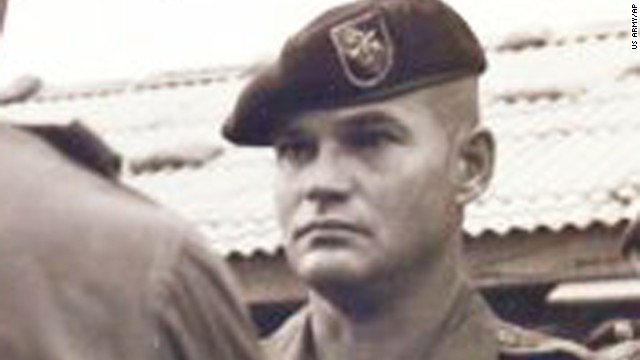 Army Command Sgt. Maj. Bennie G. Adkins is pictured in an undated U.S. Army photo. He is cited for his action at Camp A Shau in Vietnam in 1966, where the Army says he killed 135 to 175 enemy troops during a battle.
Army Command Sgt. Maj. Bennie G. Adkins is pictured in an undated U.S. Army photo. He is cited for his action at Camp A Shau in Vietnam in 1966, where the Army says he killed 135 to 175 enemy troops during a battle.  The Army says Spec. Donald Paul Sloat shielded his comrades from a grenade blast at the cost of his own life near Danang, Vietnam, in 1970.
The Army says Spec. Donald Paul Sloat shielded his comrades from a grenade blast at the cost of his own life near Danang, Vietnam, in 1970.  Lt. Alonzo Cushing (center, back row) is shown with others at Antietam, Maryland, in 1862. He died at Gettysburg in July 1863 and is cited for defending Union positions against Pickett's Charge. He was killed during the action.
Lt. Alonzo Cushing (center, back row) is shown with others at Antietam, Maryland, in 1862. He died at Gettysburg in July 1863 and is cited for defending Union positions against Pickett's Charge. He was killed during the action.  President Barack Obama awarded 24 U.S. Army veterans, including Spc. Santiago J. Erevia, pictured, with the Medal of Honor on March 18. The soldiers, only three of whom are still alive, received the country's highest military award for their courageous actions during Vietnam, Korea and World War II. Erevia was honored for his actions while serving as a radiotelephone operator in Vietnam on May 21, 1969. He is credited with tending to injured comrades when his position came under attack. He then charged the enemy before returning to care for the injured troops he left behind.
President Barack Obama awarded 24 U.S. Army veterans, including Spc. Santiago J. Erevia, pictured, with the Medal of Honor on March 18. The soldiers, only three of whom are still alive, received the country's highest military award for their courageous actions during Vietnam, Korea and World War II. Erevia was honored for his actions while serving as a radiotelephone operator in Vietnam on May 21, 1969. He is credited with tending to injured comrades when his position came under attack. He then charged the enemy before returning to care for the injured troops he left behind. 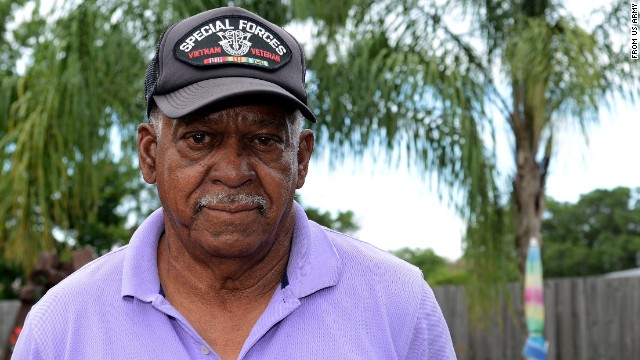 Sgt. 1st Class Melvin Morris was recognized for his heroic actions on September 17, 1969, near Chi Lang, Vietnam, where the Army Green Beret ignored his safety on no less than three occasions, charging into a hail of gunfire to save his injured comrades and retrieve the bodies of the fallen. He was wounded three times as he ran back toward friendly lines with casualties, but he did not stop until he reached safety.
Sgt. 1st Class Melvin Morris was recognized for his heroic actions on September 17, 1969, near Chi Lang, Vietnam, where the Army Green Beret ignored his safety on no less than three occasions, charging into a hail of gunfire to save his injured comrades and retrieve the bodies of the fallen. He was wounded three times as he ran back toward friendly lines with casualties, but he did not stop until he reached safety.  Sgt. 1st Class Jose Rodela was recognized for his heroic actions on September 1, 1969, in Phuoc Long Province, Vietnam, while commanding a mobile strike force. He was wounded in the back and head while trying to save a comrade. He then single-handedly assaulted a rocket position before returning to lead his men. Of the 24 recipients Tuesday, only Rodela, Morris and Erevia are still alive.
Sgt. 1st Class Jose Rodela was recognized for his heroic actions on September 1, 1969, in Phuoc Long Province, Vietnam, while commanding a mobile strike force. He was wounded in the back and head while trying to save a comrade. He then single-handedly assaulted a rocket position before returning to lead his men. Of the 24 recipients Tuesday, only Rodela, Morris and Erevia are still alive.  Sgt. Candelario Garcia distinguished himself on December 8, 1968, while serving as a team leader during a company-size reconnaissance-in-force mission near Lai Khe, Vietnam. When his company came under intense fire, leaving several men wounded and trapped in the open, he single-handedly took out two machine gun bunkers. He then joined his company in an assault, which overran the remaining enemy positions.
Sgt. Candelario Garcia distinguished himself on December 8, 1968, while serving as a team leader during a company-size reconnaissance-in-force mission near Lai Khe, Vietnam. When his company came under intense fire, leaving several men wounded and trapped in the open, he single-handedly took out two machine gun bunkers. He then joined his company in an assault, which overran the remaining enemy positions.  Spc. Leonard L. Alvarado was recognized for his actions as a rifleman on August 12, 1969, when he disrupted an enemy attack that targeted an American platoon pinned down in Vietnam's Phuoc Long province. He crawled through a fusillade of fire to save several comrades and advanced on the enemy, laying down suppressive fire before dying from his wounds.
Spc. Leonard L. Alvarado was recognized for his actions as a rifleman on August 12, 1969, when he disrupted an enemy attack that targeted an American platoon pinned down in Vietnam's Phuoc Long province. He crawled through a fusillade of fire to save several comrades and advanced on the enemy, laying down suppressive fire before dying from his wounds. 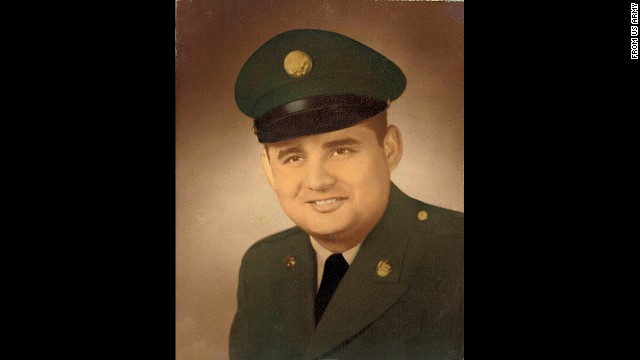 Staff Sgt. Felix M. Conde-Falcon is credited with leading soldiers in an advance on an extensive enemy bunker complex, later identified as a battalion command, on April 4, 1969, in Ap Tan Hoa, Vietnam. When they came under fire, Conde-Falcon single-handedly assaulted a fortification until he ran out of ammunition. While taking up another position, he was mortally wounded by an unseen assailant.
Staff Sgt. Felix M. Conde-Falcon is credited with leading soldiers in an advance on an extensive enemy bunker complex, later identified as a battalion command, on April 4, 1969, in Ap Tan Hoa, Vietnam. When they came under fire, Conde-Falcon single-handedly assaulted a fortification until he ran out of ammunition. While taking up another position, he was mortally wounded by an unseen assailant. 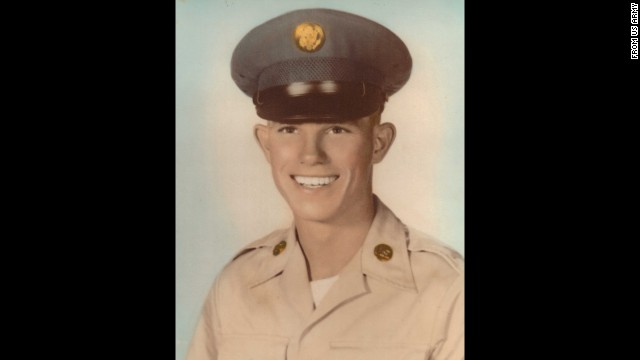 Spc. Ardie R. Copas was recognized for his actions in the early morning hours of May 12, 1970, while he served as a machine gunner near Ph Romeas Hek, Cambodia. Copas took to the machine gun on a burning vehicle, laying down fire so four of his wounded comrades could be saved. He continued firing at the enemy troops until he was mortally wounded.
Spc. Ardie R. Copas was recognized for his actions in the early morning hours of May 12, 1970, while he served as a machine gunner near Ph Romeas Hek, Cambodia. Copas took to the machine gun on a burning vehicle, laying down fire so four of his wounded comrades could be saved. He continued firing at the enemy troops until he was mortally wounded. 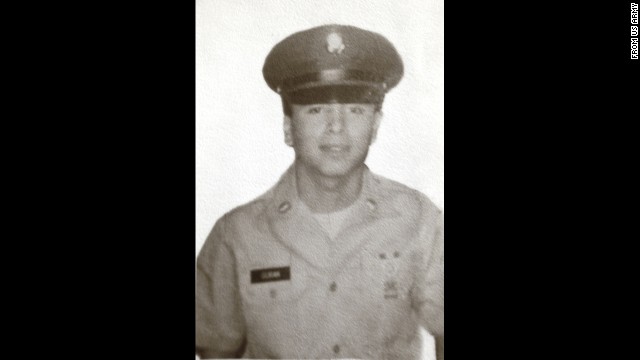 Spc. Jesus S. Duran was honored for his selflessness on April 10, 1969, while he served as a machine gunner during a search-and-destroy mission during the Vietnam War. When his platoon was ambushed during the mission, he put himself in the direct line of fire to save a number of comrades.
Spc. Jesus S. Duran was honored for his selflessness on April 10, 1969, while he served as a machine gunner during a search-and-destroy mission during the Vietnam War. When his platoon was ambushed during the mission, he put himself in the direct line of fire to save a number of comrades. 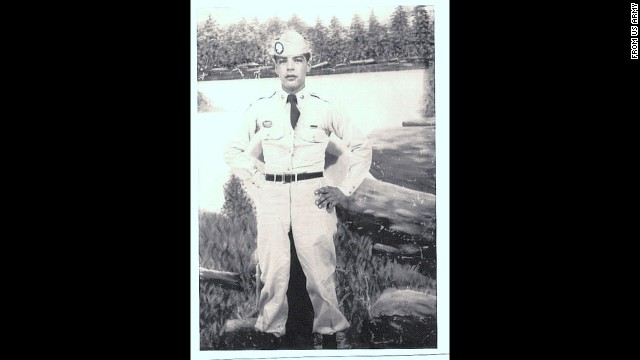 Cpl. Joe R. Baldonado, a machine gunner, is credited with repelling an enemy attack at Hill 171 in Kandong, Korea, on November 25, 1950 -- an act that was chronicled in the book "Disaster in Korea: The Chinese Confront MacArthur." With most of the platoon out of ammunition, Baldonado laid down withering fire in an exposed position, forcing the enemy to retreat. As they fled, a grenade was thrown that killed Baldonado. His body was never found.
Cpl. Joe R. Baldonado, a machine gunner, is credited with repelling an enemy attack at Hill 171 in Kandong, Korea, on November 25, 1950 -- an act that was chronicled in the book "Disaster in Korea: The Chinese Confront MacArthur." With most of the platoon out of ammunition, Baldonado laid down withering fire in an exposed position, forcing the enemy to retreat. As they fled, a grenade was thrown that killed Baldonado. His body was never found.  Cpl. Victor H. Espinoza was awarded the Medal of Honor for his actions on August 1, 1952, during what became known as the third Battle of Old Baldy in Chorwon, Korea. With his unit pinned down by enemy forces, Espinoza single-handedly took out a machine gunner and his crew, discovered and destroyed an enemy tunnel, and wiped out two bunkers.
Cpl. Victor H. Espinoza was awarded the Medal of Honor for his actions on August 1, 1952, during what became known as the third Battle of Old Baldy in Chorwon, Korea. With his unit pinned down by enemy forces, Espinoza single-handedly took out a machine gunner and his crew, discovered and destroyed an enemy tunnel, and wiped out two bunkers.  Sgt. Eduardo C. Gomez was recognized for heroic actions on September 3, 1950, at Tabu-dong, Korea, where his company was attacked while readying defensive positions. He maneuvered across open ground to take out a tank. Wounded, he refused medical care and manned his post where his weapon overheated and burned his hands. He stayed at his post, providing protective fire as the troops were ordered to withdraw.
Sgt. Eduardo C. Gomez was recognized for heroic actions on September 3, 1950, at Tabu-dong, Korea, where his company was attacked while readying defensive positions. He maneuvered across open ground to take out a tank. Wounded, he refused medical care and manned his post where his weapon overheated and burned his hands. He stayed at his post, providing protective fire as the troops were ordered to withdraw.  Pfc. Leonard M. Kravitz was recognized for his actions on March 6-7, 1951, in Yangpyeong, Korea, when his unit was overrun by enemy forces and forced to withdraw. He voluntarily remained at his position to provide suppressive fire for retreating troops, which forced the enemy to concentrate their attack on his position and saved his platoon. He was fatally wounded.
Pfc. Leonard M. Kravitz was recognized for his actions on March 6-7, 1951, in Yangpyeong, Korea, when his unit was overrun by enemy forces and forced to withdraw. He voluntarily remained at his position to provide suppressive fire for retreating troops, which forced the enemy to concentrate their attack on his position and saved his platoon. He was fatally wounded. 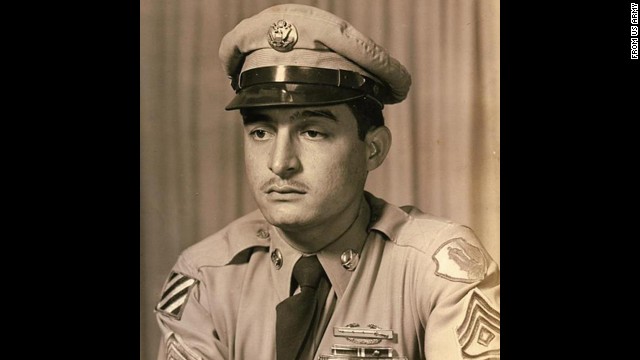 Master Sgt. Juan E. Negron distinguished himself on April 28, 1951, near Kalmaeri, Korea, where he refused to leave his post after learning enemy forces had broken through a roadblock and were advancing. He held his post throughout the night, hurling grenades and laying down fire to halt the enemy attack. He held the position until an allied counterattack was organized and launched.
Master Sgt. Juan E. Negron distinguished himself on April 28, 1951, near Kalmaeri, Korea, where he refused to leave his post after learning enemy forces had broken through a roadblock and were advancing. He held his post throughout the night, hurling grenades and laying down fire to halt the enemy attack. He held the position until an allied counterattack was organized and launched.  Master Sgt. Mike C. Pena was posthumously honored for his actions on September 4, 1950, near Waegwan, Korea, where he led a counterattack after his unit was attacked. When his troops began to run out of ammunition, he ordered his unit to retreat and then manned a machine gun to cover their withdrawal. Single-handedly, he held back the enemy troops until the early hours the following morning when he his position was overrun and he was killed.
Master Sgt. Mike C. Pena was posthumously honored for his actions on September 4, 1950, near Waegwan, Korea, where he led a counterattack after his unit was attacked. When his troops began to run out of ammunition, he ordered his unit to retreat and then manned a machine gun to cover their withdrawal. Single-handedly, he held back the enemy troops until the early hours the following morning when he his position was overrun and he was killed.  Pvt. Demensio Rivera was recognized for his actions on May 22-23, 1951, in Changyongi, Korea, where he held his forward position during an enemy attack. When his rifle became inoperable, he used a handgun and grenades. He then turned to hand-to-hand combat, using his last grenade as the enemy troops closed in. When his position was retaken, he was found wounded, lying among the bodies of four dead or dying enemy soldiers.
Pvt. Demensio Rivera was recognized for his actions on May 22-23, 1951, in Changyongi, Korea, where he held his forward position during an enemy attack. When his rifle became inoperable, he used a handgun and grenades. He then turned to hand-to-hand combat, using his last grenade as the enemy troops closed in. When his position was retaken, he was found wounded, lying among the bodies of four dead or dying enemy soldiers. 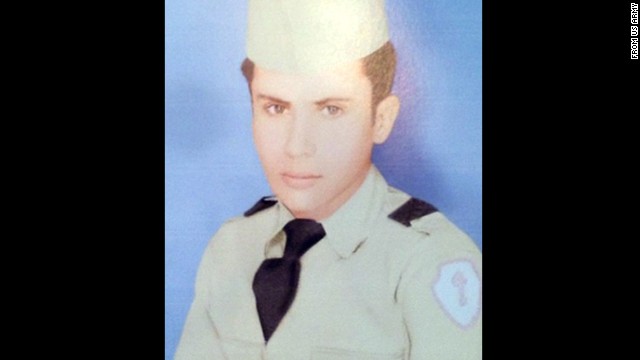 Pvt. Miguel A. Vera was posthumously honored for his actions on September 21, 1952, while volunteering for an assault in the Battle of Mount Baldy in Chorwon, Korea. He and others climbed a bare, rocky slope and got within 20 yards of enemy forces before they were forced to pull back because of intense fire. He remained behind to cover his comrades as they withdrew before being mortally wounded.
Pvt. Miguel A. Vera was posthumously honored for his actions on September 21, 1952, while volunteering for an assault in the Battle of Mount Baldy in Chorwon, Korea. He and others climbed a bare, rocky slope and got within 20 yards of enemy forces before they were forced to pull back because of intense fire. He remained behind to cover his comrades as they withdrew before being mortally wounded.  Sgt. Jack Weinstein was recognized for his actions on October 19, 1951, near Kumsong, Korea, where he is credited with single-handedly holding his position during an enemy counterattack to allow his men to withdraw. Wounded in the leg, he held the position until a platoon relieved him and pushed the enemy back.
Sgt. Jack Weinstein was recognized for his actions on October 19, 1951, near Kumsong, Korea, where he is credited with single-handedly holding his position during an enemy counterattack to allow his men to withdraw. Wounded in the leg, he held the position until a platoon relieved him and pushed the enemy back. 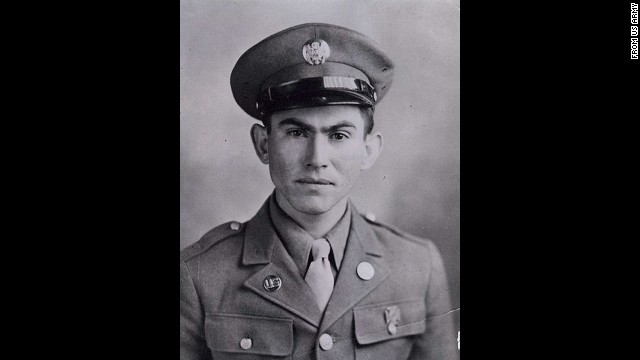 Pvt. Pedro Cano was honored for his action in the Battle of Hurtgen Forest near Schevenhutte, Germany, in December 1944. During a two-day period, he eliminated 30 enemy troops, according to the Army. Sometime later, when his platoon was attacked, he laid motionless on the ground until enemy soldiers closed in. Then he tossed a grenade, wounding or killing all of them.
Pvt. Pedro Cano was honored for his action in the Battle of Hurtgen Forest near Schevenhutte, Germany, in December 1944. During a two-day period, he eliminated 30 enemy troops, according to the Army. Sometime later, when his platoon was attacked, he laid motionless on the ground until enemy soldiers closed in. Then he tossed a grenade, wounding or killing all of them.  Pvt. Joe Gandara was recognized for heroic actions on June 9, 1944, in Amfreville, France, where his detachment came under enemy fire from German forces. The men were trapped for hours until Gandara advanced voluntarily and alone toward the German position, where he destroyed three machine gun positions before being fatally wounded.
Pvt. Joe Gandara was recognized for heroic actions on June 9, 1944, in Amfreville, France, where his detachment came under enemy fire from German forces. The men were trapped for hours until Gandara advanced voluntarily and alone toward the German position, where he destroyed three machine gun positions before being fatally wounded.  Pfc. Salvador J. Lara was honored for his extraordinary heroism in action on May 27-28, 1944, near Aprilia, Italy, during the Battle of Anzio when his unit came under fire by German forces. He is credited with leading his rifle company to inflict a large number of enemy casualties. He was wounded during the fighting but did not stop to receive medical attention. As the fighting continued, he was credited with saving a number of U.S. troops after he crawled alone to a machine gun pit where he killed three German soldiers.
Pfc. Salvador J. Lara was honored for his extraordinary heroism in action on May 27-28, 1944, near Aprilia, Italy, during the Battle of Anzio when his unit came under fire by German forces. He is credited with leading his rifle company to inflict a large number of enemy casualties. He was wounded during the fighting but did not stop to receive medical attention. As the fighting continued, he was credited with saving a number of U.S. troops after he crawled alone to a machine gun pit where he killed three German soldiers.  Sgt. William F. Leonard was honored for his actions while serving as a squad leader on November 7, 1944, near St. Die, France, where he led the eight survivors of his platoon, which had been decimated by enemy fire, in assault over a hill. Killing two snipers at ranges of 50 and 75 yards, he continued to fight even after being shot in the back. He knocked out a machine gun pit. After being stunned by a bazooka shell, he continued his advance and took out another machine gun pit and captured their objective -- a roadblock.
Sgt. William F. Leonard was honored for his actions while serving as a squad leader on November 7, 1944, near St. Die, France, where he led the eight survivors of his platoon, which had been decimated by enemy fire, in assault over a hill. Killing two snipers at ranges of 50 and 75 yards, he continued to fight even after being shot in the back. He knocked out a machine gun pit. After being stunned by a bazooka shell, he continued his advance and took out another machine gun pit and captured their objective -- a roadblock.  Staff Sgt. Manuel V. Mendoza was recognized for his action on October 4, 1944, in Mount Battaglia, Italy, where he is credited with single-handedly breaking up a German counterattack. Mendoza, already wounded in the arm and the leg in the attack, grabbed a submachine gun and opened fire on German troops advancing up a hill. When the German soldiers retreated, he grabbed a number of weapons dropped in the retreat. He also captured a wounded enemy soldier.
Staff Sgt. Manuel V. Mendoza was recognized for his action on October 4, 1944, in Mount Battaglia, Italy, where he is credited with single-handedly breaking up a German counterattack. Mendoza, already wounded in the arm and the leg in the attack, grabbed a submachine gun and opened fire on German troops advancing up a hill. When the German soldiers retreated, he grabbed a number of weapons dropped in the retreat. He also captured a wounded enemy soldier.  Sgt. Alfred B. Nietzel distinguished himself on November 18, 1944, in Heistern, Germany, where he is credited with holding his position long enough during a German assault to allow for reinforcements to arrive and stop the advance. As the enemy closed in on his position, he ordered the three remaining members of his squad to retreat and get reinforcements while he continued firing. He was killed by enemy grenade.
Sgt. Alfred B. Nietzel distinguished himself on November 18, 1944, in Heistern, Germany, where he is credited with holding his position long enough during a German assault to allow for reinforcements to arrive and stop the advance. As the enemy closed in on his position, he ordered the three remaining members of his squad to retreat and get reinforcements while he continued firing. He was killed by enemy grenade.  First Lt. Donald K. Schwab distinguished himself with his actions on September 7, 1944, when led his company over 400 yards of open ground near Lure, France, in an assault that was credited with leaving German troops so disorganized that it broke their line. As part of it, he attacked a machine gun nest, hit the German gunner with the butt of his rifle and dragged him back through a hail of fire to friendly lines.
First Lt. Donald K. Schwab distinguished himself with his actions on September 7, 1944, when led his company over 400 yards of open ground near Lure, France, in an assault that was credited with leaving German troops so disorganized that it broke their line. As part of it, he attacked a machine gun nest, hit the German gunner with the butt of his rifle and dragged him back through a hail of fire to friendly lines.
- Sgt. Maj. Bennie Adkins honored for his actions in Vietnam in 1966
- Adkins was wounded 18 times during the battle for Camp A Shau
- Adkins fought and evaded North Vietnamese troops for 86 hours before he was rescued
(CNN) -- As many as 175 enemy troops killed, 18 wounds from enemy fire, 38 hours of battle, 48 hours evading the North Vietnamese troops in the bush -- and one tiger. Those are the numbers behind Sgt. Maj. Bennie Adkins' Medal of Honor, an award he received from President Barack Obama in a White House ceremony Monday.
Adkins of Opelika, Alabama, was honored for his actions in Vietnam's A Shau Valley more than 48 years ago. Then a 32-year-old sergeant first class, Adkins was among a handful of Americans working with troops of the South Vietnamese Civilian Irregular Defense Group at Camp A Shau when the camp was attacked by a large North Vietnamese and Viet Cong force on March 9, 1966, according to an Army report.
"Adkins rushed through intense enemy fire and manned a mortar position defending the camp," the Army report says. "He continued to mount a defense even while incurring wounds from several direct hits from enemy mortars. Upon learning that several soldiers were wounded near the center of camp, he temporarily turned the mortar over to another soldier, ran through exploding mortar rounds and dragged several comrades to safety. As the hostile fire subsided, Adkins exposed himself to sporadic sniper fire and carried his wounded comrades to a more secure position."
Later, under enemy fire, some of it coming from South Vietnamese allies who had defected to the North during the battle, Adkins took wounded troops to an airstrip outside the camp for evacuation and drew enemy fire away from the evacuation aircraft. He went outside the camp again to retrieve supplies from an airdrop that fell into a minefield. And that was just day one.
"The bottom line is that it was just not my day to go," Adkins said in an Army interview at Fort Benning, Georgia, last week.
 He killed up to 175 enemy troops
He killed up to 175 enemy troops 
 Former U.S. Army Staff Sgt. Ryan J. Pitts receives the Medal of Honor on Monday, July 21, for his actions during a battle in Afghanistan in 2008. According to the Army, Pitts launched grenade after grenade under a hail of enemy gunfire as comrades at other nearby posts fell. He also asked other soldiers to fire at his position to prevent the enemy from gaining ground. Click through to see other Afghanistan veterans who have received the Medal of Honor, the nation's highest award for valor in combat.
Former U.S. Army Staff Sgt. Ryan J. Pitts receives the Medal of Honor on Monday, July 21, for his actions during a battle in Afghanistan in 2008. According to the Army, Pitts launched grenade after grenade under a hail of enemy gunfire as comrades at other nearby posts fell. He also asked other soldiers to fire at his position to prevent the enemy from gaining ground. Click through to see other Afghanistan veterans who have received the Medal of Honor, the nation's highest award for valor in combat. 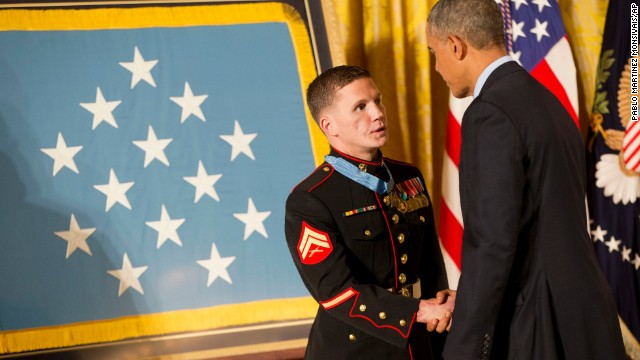 Retired Marine Cpl. Kyle Carpenter shakes hands with President Barack Obama as he receives the Medal of Honor on June 19. While serving in Afghanistan, Carpenter used his body to shield a fellow Marine from a grenade blast on November 21, 2010.
Retired Marine Cpl. Kyle Carpenter shakes hands with President Barack Obama as he receives the Medal of Honor on June 19. While serving in Afghanistan, Carpenter used his body to shield a fellow Marine from a grenade blast on November 21, 2010. 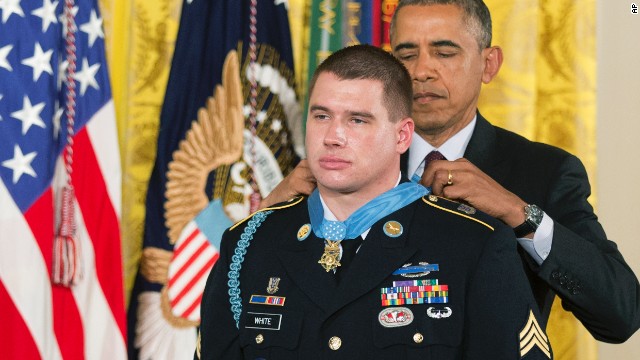 Army Sgt. Kyle White receives the Medal of Honor during a ceremony at the White House on May 13. He was recognized for repeatedly exposing himself to enemy fire in Afghanistan while trying to save the lives of fellow soldiers in November 2007.
Army Sgt. Kyle White receives the Medal of Honor during a ceremony at the White House on May 13. He was recognized for repeatedly exposing himself to enemy fire in Afghanistan while trying to save the lives of fellow soldiers in November 2007. 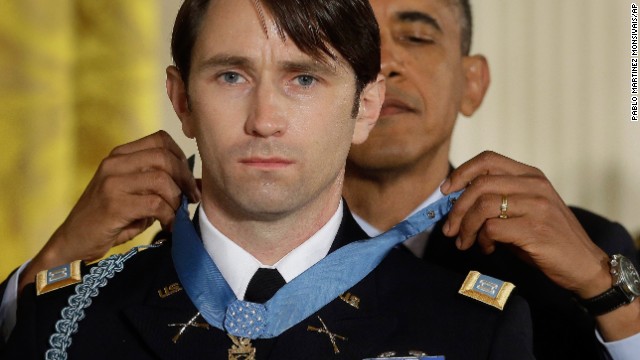 President Obama gives former Army Capt. William Swenson the Medal of Honor during a White House ceremony on October 15, 2013. Swenson was cited for "his exceptional leadership and stout resistance against the enemy during six hours of continuous fighting" in 2009, according to the Army.
President Obama gives former Army Capt. William Swenson the Medal of Honor during a White House ceremony on October 15, 2013. Swenson was cited for "his exceptional leadership and stout resistance against the enemy during six hours of continuous fighting" in 2009, according to the Army. 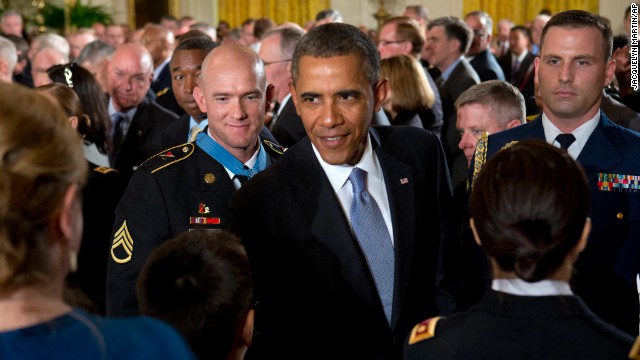 Army Staff Sgt. Ty M. Carter, left, watches as President Obama greets family members of fallen service members after Carter was awarded the Medal of Honor during a White House ceremony on August 26, 2013. Carter was cited for his actions during the October 3, 2009, defense of Command Outpost Keating in Afghanistan, including "running through a hail of enemy rocket propelled grenade and machine gun fire to rescue a critically wounded comrade."
Army Staff Sgt. Ty M. Carter, left, watches as President Obama greets family members of fallen service members after Carter was awarded the Medal of Honor during a White House ceremony on August 26, 2013. Carter was cited for his actions during the October 3, 2009, defense of Command Outpost Keating in Afghanistan, including "running through a hail of enemy rocket propelled grenade and machine gun fire to rescue a critically wounded comrade."  President Obama presents the Medal of Honor to Army Staff Sgt. Clinton Romesha at the White House on February 11, 2013. Wounded early in the battle at Command Outpost Keating on October 3, 2009, Romesha "continually exposed himself to heavy enemy fire as he moved confidently about the battlefield engaging and destroying multiple enemy targets," according to the Army.
President Obama presents the Medal of Honor to Army Staff Sgt. Clinton Romesha at the White House on February 11, 2013. Wounded early in the battle at Command Outpost Keating on October 3, 2009, Romesha "continually exposed himself to heavy enemy fire as he moved confidently about the battlefield engaging and destroying multiple enemy targets," according to the Army. 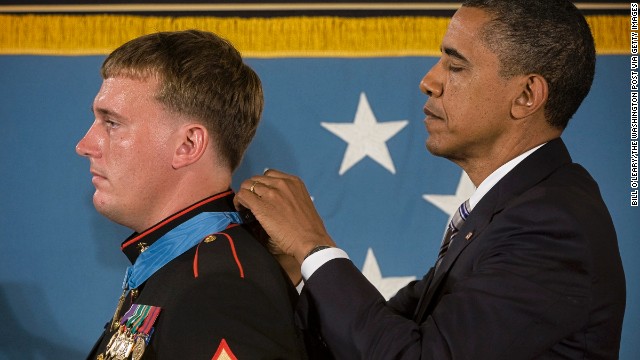 President Obama awards the Medal of Honor to Marine Sgt. Dakota Meyer on September 15, 2011. In fighting at Gangjal, Afghanistan, on September 8, 2009, while manning a gun truck, "Meyer killed a number of enemy fighters with the mounted machine guns and his rifle, some at near point blank range, as he and his driver made three solo trips into the ambush area," his citation said.
President Obama awards the Medal of Honor to Marine Sgt. Dakota Meyer on September 15, 2011. In fighting at Gangjal, Afghanistan, on September 8, 2009, while manning a gun truck, "Meyer killed a number of enemy fighters with the mounted machine guns and his rifle, some at near point blank range, as he and his driver made three solo trips into the ambush area," his citation said.  President Obama walks with Army Sgt. 1st Class Leroy Arthur Petry, who received the Medal of Honor on July 12, 2011. Petry was cited for his actions during a battle in Paktya province, Afghanistan, on May 26, 2008, which included picking up an enemy grenade thrown at him and fellow soldiers. As he was about to throw it away, the grenade exploded and blew off his right hand, according to his citation.
President Obama walks with Army Sgt. 1st Class Leroy Arthur Petry, who received the Medal of Honor on July 12, 2011. Petry was cited for his actions during a battle in Paktya province, Afghanistan, on May 26, 2008, which included picking up an enemy grenade thrown at him and fellow soldiers. As he was about to throw it away, the grenade exploded and blew off his right hand, according to his citation.  President Obama applauds after presenting the Medal of Honor to Army Staff Sgt. Salvatore Giunta on November 16, 2010. Cited for his actions in the Korengal Valley, Afghanistan, in October 2007, Guinta was the first living recipient of the Medal of Honor since the Vietnam War.
President Obama applauds after presenting the Medal of Honor to Army Staff Sgt. Salvatore Giunta on November 16, 2010. Cited for his actions in the Korengal Valley, Afghanistan, in October 2007, Guinta was the first living recipient of the Medal of Honor since the Vietnam War.  Phil and Maureen Miller receive the Medal of Honor on behalf of their son, Army Staff Sgt. Robert J. Miller, on October 6, 2010. The soldier was cited for engaging more than 100 enemy fighters in the Gowardesh Valley, Afghanistan, on January 25, 2008. Miller killed 10 of the enemy and wounded dozens more before being mortally wounded by enemy fire.
Phil and Maureen Miller receive the Medal of Honor on behalf of their son, Army Staff Sgt. Robert J. Miller, on October 6, 2010. The soldier was cited for engaging more than 100 enemy fighters in the Gowardesh Valley, Afghanistan, on January 25, 2008. Miller killed 10 of the enemy and wounded dozens more before being mortally wounded by enemy fire.  Paul and Janet Monti receive the Medal of Honor for their son, Army Sgt. First Class Jared C. Monti, on September 17, 2009. Monti was killed June 21, 2006, in Nuristan province, Afghanistan, while attempting to rescue one of his fellow soldiers and fighting off an attack from insurgents.
Paul and Janet Monti receive the Medal of Honor for their son, Army Sgt. First Class Jared C. Monti, on September 17, 2009. Monti was killed June 21, 2006, in Nuristan province, Afghanistan, while attempting to rescue one of his fellow soldiers and fighting off an attack from insurgents. 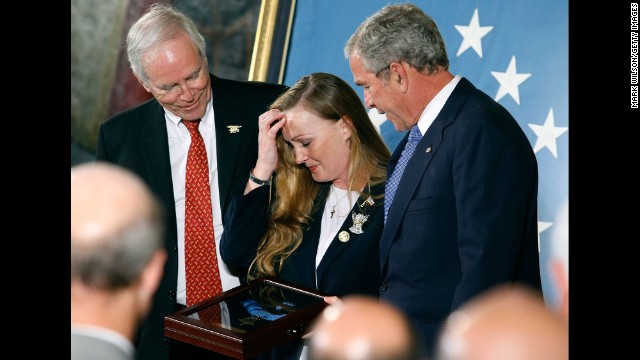 President George W. Bush presents the Medal of Honor to Daniel and Maureen Murphy, parents of Navy Lt. Michael Murphy, on October 22, 2007. Murphy, a Navy SEAL, was killed June 28, 2005, when his four-man team was assaulted by 30 to 40 enemy fighters. Murphy exposed himself to repeated enemy fire while trying to radio for help for his besieged team, his citation said.
President George W. Bush presents the Medal of Honor to Daniel and Maureen Murphy, parents of Navy Lt. Michael Murphy, on October 22, 2007. Murphy, a Navy SEAL, was killed June 28, 2005, when his four-man team was assaulted by 30 to 40 enemy fighters. Murphy exposed himself to repeated enemy fire while trying to radio for help for his besieged team, his citation said. Afghanistan vets receive Medal of Honor
Afghanistan vets receive Medal of Honor
Afghanistan vets receive Medal of Honor
Afghanistan vets receive Medal of Honor
Afghanistan vets receive Medal of Honor
Afghanistan vets receive Medal of Honor
Afghanistan vets receive Medal of Honor
Afghanistan vets receive Medal of Honor
Afghanistan vets receive Medal of Honor
Afghanistan vets receive Medal of Honor
Afghanistan vets receive Medal of Honor
Afghanistan vets receive Medal of Honor
 Afghanistan vets receive Medal of Honor
Afghanistan vets receive Medal of Honor The fighting, and Adkins' heroism, continued in the early morning of March 10 when the North Vietnamese hit the camp with their main attack, according to the Army report.
"Within two hours, Sergeant First Class Adkins was the only defender firing a mortar weapon. When all mortar rounds were expended, Adkins began placing effective rifle fire upon enemy as they infiltrated the camp perimeter and assaulted his position. Despite receiving additional wounds from enemy rounds exploding on his position, Adkins fought off relentless waves of attacking North Vietnamese soldiers," the Army report says.
After falling back to a smaller bunker in Camp A Shau, Adkins killed more enemy troops with small arms fire, destroyed equipment and classified documents to prevent them from getting into North Vietnamese hands, and led a group of soldiers in digging their way out of the rear of the bunker and escaping the besieged camp.
But Adkins' ordeal was not over. Because he was carrying a wounded comrade, he and his small group couldn't get to the evacuation helicopters sent to pick up the battle's survivors. The band faded into the jungle, avoiding their North Vietnamese pursuers for 48 hours.
And that's where the tiger comes in.
"The North Vietnamese soldiers had us surrounded on a little hilltop and everything started getting kind of quiet," Adkins is quoted as saying in an Army report. "We could look around and all at once, all we could see were eyes going around us. It was a tiger that stalked us that night. We were all bloody and in this jungle, the tiger stalked us and the North Vietnamese soldiers were more afraid of the tiger than they were of us. So, they backed off some and we were (able to escape)."
The scene in Camp A Shau, Vietnam, after the battle in March 1966.
Helicopters rescued Adkins and the rest of his group on March 12.
The Army says Adkins killed 135 to 175 enemy soldiers during the Camp A Shau battle. He suffered 18 wounds during the 86-hour ordeal.
Forty-eight years later, Adkins doesn't cite those numbers but two others.
"I'm just a keeper of the medal for those other 16 (U.S. troops) who were in the battle, especially the five who didn't make it," he told Army News Service.
"I can tell you every man who was there and the five who lost their lives. I can tell you how that happened. It diminishes, but it does not go away," Adkins said.
And he remembers the South Vietnamese who stuck by his side.
"There were about 410 indigenous Civilian Irregular Defense Group soldiers there with us, and of those, only about 122 survived, and most of those were wounded. It was a horrible, horrible battle. There was valor on all sides, not only from the Americans, but from the CIDG soldiers also," he's quoted as saying in an Army report.
Spc. Donald Paul Sloat is credited with shielding comrades from a grenade near Danang, Vietnam, in January 1970.
Others to receive honor
Honored with Adkins at the White House ceremony was one other soldier, posthumously.
Spc. Donald P. Sloat was awarded the Medal of Honor for his actions in using his body to shield comrades from a grenade blast near Danang, Vietnam, in January 1970.
Additionally, the White House has announced one more Medal of Honor recipient: From the Civil War, 1st Lt. Alonzo H. Cushing, who held out against Confederate troops during Pickett's Charge on July 3, 1863, part of the Battle of Gettysburg.
Cushing manned the last serviceable Union artillery battery during the Confederate assault, which came within 100 yards of his position. He was killed by Confederate gunfire.
"His actions made it possible for the Union Army to successfully repulse the Confederate assault," a White House statement said.
A ceremony for the presentation of Cushing's honor has yet to be announced, the White House said.
No comments:
Post a Comment